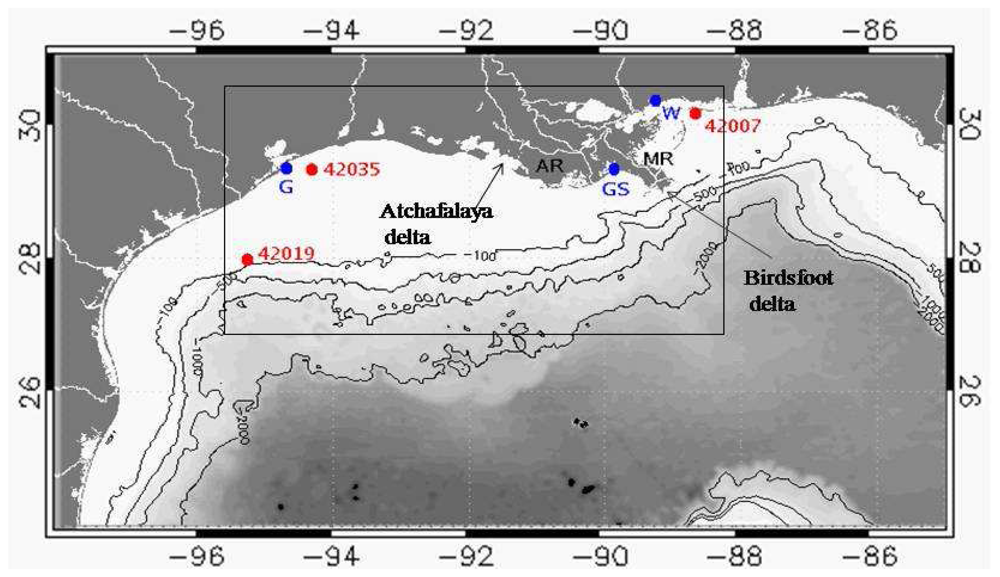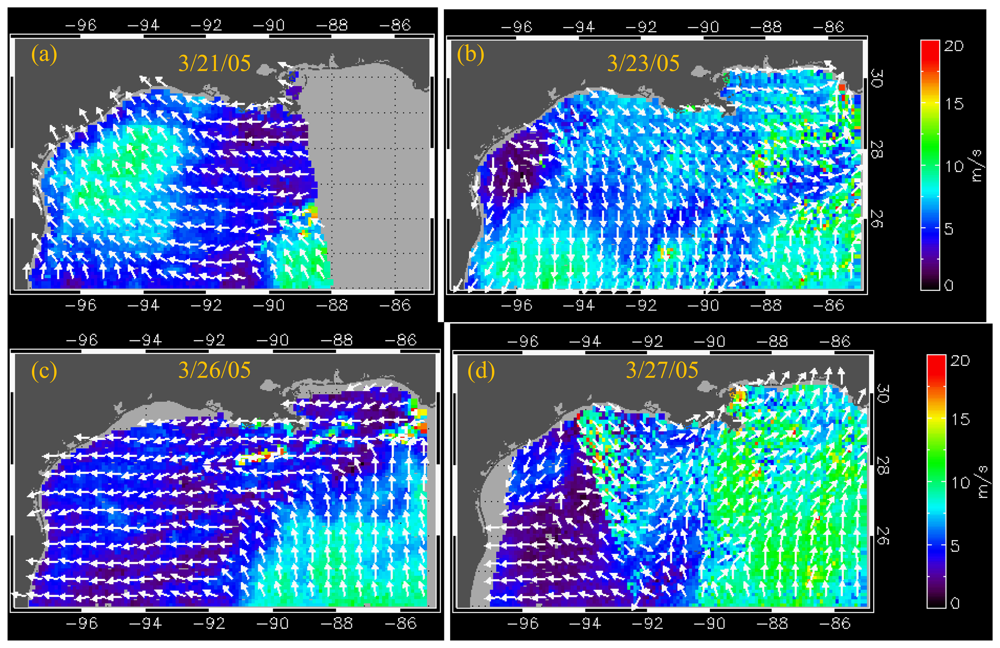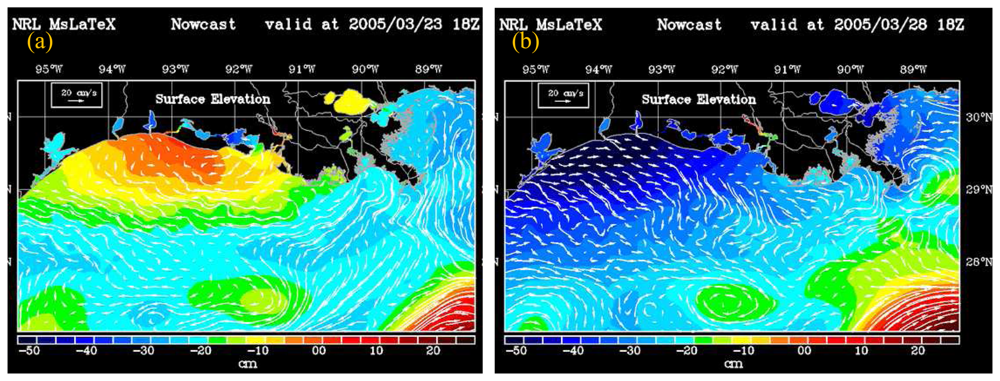Short-term Influences on Suspended Particulate Matter Distribution in the Northern Gulf of Mexico: Satellite and Model Observations
Abstract
:1. Introduction
2. Methods and Data
2.1 Study site and data
2.2 Remote sensing data
2.3 MsLaTex (Mississippi-Louisiana-Texas) coastal model
3. Results and discussion
3.1 Physical properties in the northern Gulf of Mexico
3.2 Cold front passage – wind forcing effects on sea level and currents
3.3 Frontal passage effects on particle dynamics
4. Conclusions
Acknowledgments
References and Notes
- Chassignet, E.P.; Hurlburt, H.E.; Smedstad, O.M.; Barron, C.N.; Ko, D.S.; Rhodes, R.C.; Shriver, J.F.; Wallcraft, A.J.; Arnone, R.A. Assessment of data assimilative ocean models in the Gulf of Mexico using ocean color. Circulation in the Gulf of Mexico: Observations and models 2005, 87–100. [Google Scholar]
- Cochrane, W.S.; Kelly, F.J. Low-frequency circulation on the Texas-Louisiana shelf. Journal of Geophysical Research 1986, 91(10), 645–10, 659. [Google Scholar]
- D'Sa, E.J.; Miller, R.L. Bio-optical properties in waters influenced by the Mississippi River during low flow conditions. Remote Sensing of Environment 2003, 84, 538–549. [Google Scholar]
- D'Sa, E.J.; Miller, R.L.; Del Castillo, C. Bio-optical properties and ocean color algorithms for coastal waters influenced by the Mississippi River during a cold front. Applied Optics 2006, 45, 7410–7428. [Google Scholar]
- D'Sa, E.J.; Miller, R.L.; McKee, B.A. Suspended particulate matter dynamics in coastal waters from ocean color: Applications to the Northern Gulf of Mexico. Geophysical Research Letters 2007, 34, L23611. [Google Scholar] [CrossRef]
- D'Sa, E.J.; Ko, D.S.; Korobkin, M. Comparison of sea surface heights derived from the navy coastal ocean model with satellite altimetry in the Gulf of Mexico. Proceedings, 12th Conference on IOAS-AOLS 2008, P2.9. [Google Scholar]
- Forget, P.; André, G. Can satellite-derived chlorophyll imagery be used to trace surface dynamics in coastal zone? A case study in the northwestern Mediterranean Sea. Sensors 2007, 7, 884–904. [Google Scholar]
- Georgiou, I.Y.; FitzGerald, D.M.; Stone, G.W. The impact of physical processes along the Louisiana coast. Journal of Coastal Research 2005, 44, 72–89. [Google Scholar]
- Gordon, H.R.; Wang, M. Retrieval of water-leaving radiance and aerosol optical thickness over oceans with SeaWiFS: A preliminary algorithm. Applied Optics 1994, 33, 443–452. [Google Scholar]
- Green, R.E.; Gould, R.W.; Ko, D.S. Statistical models for sediment/detritus and dissolved absorption coefficients in coastal waters of the northern Gulf of Mexico. Continental Shelf Research 2008, 28, 1273–1285. [Google Scholar]
- Hamilton, P.T.; Berger, T.J.; Johnson, W. On the structure and motions of cyclones in the northern Gulf of Mexico. Journal of Geophysical Research 2002, 107, 3208. [Google Scholar] [CrossRef]
- Ko, D.S.; Preller, R.H.; Martin, P.J. An Experimental Real-Time Intra Americas Sea Ocean Nowcast/Forecast System for Coastal Prediction. Proceedings, AMS 5th Conference on Coastal Atmospheric and Oceanic Prediction and Processes 2003, 97–100. [Google Scholar]
- Ko, D.S.; Martin, P.J.; Rowley, C.D.; Preller, R.H. A real-time coastal ocean prediction experiment for MREA04. Journal of Marine Systems 2008, 69, 17–28. [Google Scholar]
- Lohrenz, S.E.; Fahnenstiel, G.L.; Redalje, D.G.; Lang, G.A.; Dagg, M.J.; Whitledge, T.E.; Dortch, Q. Nutrients, irradiance, and mixing as factors regulating primary production in coastal waters impacted by the Mississippi River plume. Continental Shelf Research 1999, 19, 1113–1141. [Google Scholar]
- Loisel, H.; Nicolas, J.-M.; Sciandra, A.; Poteau, A. Spectral dependency of optical backscattering by marine particles from satellite remote sensing of the global ocean. Journal of Geophysical Research 2006, 111, C09024. [Google Scholar] [CrossRef]
- Martin, P.J. Description of the Navy Coastal Ocean Model Version 1.0. Technical Report 2000, NRL/FR/7322-00-9962. 42 pp. [Google Scholar]
- Meade, R.H. River-sediment inputs to major deltas. In Sea-level rise and coastal subsidence; causes, consequences and strategies; Milliman, J.D., Haq, B.U., Eds.; Kluwer: New York, 1996; pp. 63–85. [Google Scholar]
- Miller, R.L.; McKee, B.A. Using MODIS Terra 250 m imagery to map concentrations of suspended matter in coastal waters. Remote Sensing of Environment 2004, 93, 259–266. [Google Scholar]
- Moeller, C.C.; Huh, O.K.; Roberts, H.H.; Gumley, L.E.; Menzel, W.P. Response of Louisiana coastal environments to a cold front passage. Journal of Coastal Research 1993, 9, 434–447. [Google Scholar]
- Mohn, C.; White, M. Remote sensing and modeling of bio-physical distribution patterns at Porcupine and Rockall Bank, Northeast Atlantic. Continental Shelf Research 2007, 7, 1875–1892. [Google Scholar]
- Mossa, J.; Roberts, H.H. Synergism of riverine and winter storm-related sediment transport processes in Louisiana's coastal wetlands. Transactions of the Gulf Coast Associations of Geological Societies 1990, 40, 635–642. [Google Scholar]
- Murray, S.P. Observationson wind, tidal and density-driven currents in the vicinity of the Mississippi River delta. In Shelf sediment transport; Swift, D.T.P., Duane, D.B., Pilkey, O.H., Eds.; Dowden, Hutchinson and Ross: Pennsylvania, 1972; pp. 127–142. [Google Scholar]
- Myint, S. W.; Walker, N. D. Quantification of surface suspended sediments along a river dominated coast with NOAA AVHRR and SeaWiFS measurements: Louisiana, USA. International Journal of Remote Sensing 2002, 23, 3229–3249. [Google Scholar]
- Nowlin, W.D.; Parker, C.A. Effects of a cold-air outbreak on shelf waters of the Gulf of Mexico. Journal of Physical Oceanography 1974, 4, 467–486. [Google Scholar]
- Nowlin, W.D.; Jochens, A.E.; DiMarco, S.F.; Reid, R.O.; Howard, M.K. Low-frequency circulation over the Texas-Louisiana shelf. In Circulation in the Gulf of Mexico: Observations and models; Geophysical Monograph Series 161; 2005; AGU; pp. 219–240. [Google Scholar]
- Oey, L.-Y.; Ezer, T.; Forristall, G.; Cooper, C.; DiMarco, S.; Fran, S. An exercise in forecasting loop current and eddy frontal positions in the Gulf of Mexico. Geophysical Research Letters 2005, 32, L12611. [Google Scholar] [CrossRef]
- Roberts, H.H.; Huh, O.K.; Hsu, S.A.; Rouse, L.J., Jr.; Rickman, D. Impact of cold-front passages on geomorphic evolution and sediment dynamics of the complex Louisiana coast. Proceedings of Coastal Sediments' 87, New Orleans, Louisiana; 1987; pp. 1950–1963. [Google Scholar]
- Roberts, H.H.; Beaubouef, R.T.; Walker, N.D.; Stone, G.W.; Bentley, S.; Sheremet, A.; Heerden, V. Sandrich bay head deltas in the Atchafalaya Bay (Louisiana): winnowing by cold front forcing. Proceedings of Coastal Sediments'03, Clearwater, Florida; 2003. [Google Scholar]
- Salisbury, J.E.; Campbell, J.W.; Linder, E.; Meeker, L.D.; Muller-Karger, F.E.; Vorosmarty, C.J. On the seasonal correlation of surface particle fields with wind stress and Mississippi discharge in the northern Gulf of Mexico. Deep-Sea Research II 2004, 51, 1187–1203. [Google Scholar]
- Stone, G.W.; McBride, R.A. Louisiana barrier islands and their importance in wetland protection: forecasting shoreline change and subsequent response of wave climate. Journal of Coastal Research 1998, 14, 900–915. [Google Scholar]
- Sharma, N.; D'Sa, E.J. Assessment and analysis of QuikSCAT vector wind products for the Gulf of Mexico: A long-term and hurricane analysis. Sensors 2008, 8, 1927–1949. [Google Scholar]
- Tang, W.; Liu, W.T.; Stiles, B.W. Evaluation of High-Resolution Ocean Surface Vector Winds Measured by QuikSCAT Scatterometer in Coastal Regions. IEEE Transactions on Geoscience and Remote Sensing 2004, 42(8), 1762–1769. [Google Scholar]
- Walker, N.D.; Huh, O.K.; Rouse, L.J., Jr.; Murray, S.P. Evolution and structure of a coastal squirt off the Mississippi River delta: Northern Gulf of Mexico. Journal of Geophysical Research 1996, 101(20). [Google Scholar]
- Walker, N.D.; Hammack, A.B. Impacts of winter storms on circulation and sediment transport: Atchafalaya-Vermilion bay region, Louisiana, USA. Journal of Coastal Research 2000, 16, 996–1010. [Google Scholar]
- Walker, N.D.; Wiseman, W.J.; Rouse, L.J.; Babin, A. Effects of river discharge, wind stress, and slope eddies on circulation and satellite-observed structure of the Mississippi River plume. Journal of Coastal Research 2005, 21, 1228–1244. [Google Scholar]
- Wiseman, W.J.; Kelly, F.J. Salinity variability within the Louisiana coastal current during the 1982 flood season. Estuaries 1994, 17, 732–739. [Google Scholar]
- Wiseman, W.J.; Rabalais, N.N.; Turner, R.E.; Dinnel, S.P.; MacNaughton, A. A seasonal andinterannual variability within the Louisiana coastal current: stratification and hypoxia. Journal ofMarine Systems 1997, 12, 237–248. [Google Scholar]
- Wollast, R. The coastal organic carbon cycle: fluxes, sources and sinks. In Ocean Margin Processes in Global Change; Mantoura, R.F., Martin, J.-M., Wollast, R., Eds.; Wiley: London, 1991; pp. 364–382. [Google Scholar]






| Satellite sensor/dates | 3/21/05 | 3/23/05 | 3/26/05 | 3/27/05 | 3/28/05 |
|---|---|---|---|---|---|
| QuikSCAT | x | x | x | x | |
| SeaWiFS | x | x |
© 2008 by the authors; licensee Molecular Diversity Preservation International, Basel, Switzerland. This article is an open-access article distributed under the terms and conditions of the Creative Commons Attribution license (http://creativecommons.org/licenses/by/3.0/).
Share and Cite
D’Sa, E.J.; Ko, D.S. Short-term Influences on Suspended Particulate Matter Distribution in the Northern Gulf of Mexico: Satellite and Model Observations. Sensors 2008, 8, 4249-4264. https://doi.org/10.3390/s8074249
D’Sa EJ, Ko DS. Short-term Influences on Suspended Particulate Matter Distribution in the Northern Gulf of Mexico: Satellite and Model Observations. Sensors. 2008; 8(7):4249-4264. https://doi.org/10.3390/s8074249
Chicago/Turabian StyleD’Sa, Eurico J., and Dong S. Ko. 2008. "Short-term Influences on Suspended Particulate Matter Distribution in the Northern Gulf of Mexico: Satellite and Model Observations" Sensors 8, no. 7: 4249-4264. https://doi.org/10.3390/s8074249




